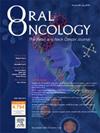桡动脉逆行前臂皮瓣在口腔颌面部重建中的创新应用。
IF 4
2区 医学
Q1 DENTISTRY, ORAL SURGERY & MEDICINE
引用次数: 0
摘要
简介:本研究旨在介绍一种使用桡动脉逆行前臂近端皮瓣(RARPFF)重建口腔颌面部缺损的新方法,并评估前臂皮瓣直接闭合供区的有效性和安全性及其对供区手功能的影响:对2021年6月至2024年4月期间接受RARPFF口腔颌面重建术的30名患者进行前瞻性研究,评估皮瓣的安全性和有效性及其对供区手功能的影响:皮瓣存活率为 93.3%。结果:皮瓣存活率为 93.3%,30 例患者中有 28 例的供区缺损基本愈合。所有供体部位均可直接缝合,未出现拇指或腕部分裂、肌腱外露或麻木等并发症。在握力方面观察到了明显的统计学差异(MD = 4.56,P 结论):反向桡动脉前臂近端皮瓣是一种可靠、安全的头颈部重建技术。这种方法能有效减少供体部位的并发症,同时保留手部功能。本文章由计算机程序翻译,如有差异,请以英文原文为准。
Innovative use of radial artery retrograde forearm flap for oral and maxillofacial reconstruction
Introduction
The purpose of this study is to present a novel method of reconstructing oral and maxillofacial defects using the Radial Artery Retrograde Proximal Forearm Flap (RARPFF) and to evaluate the efficacy and safety of the forearm flap for direct closure of the donor site and its effect on hand function in the donor area.
Methods
A prospective study of 30 patients who underwent oral and maxillofacial reconstruction with RARPFF between June 2021 and April 2024 was conducted to evaluate the safety and efficacy of the flap and its influence on hand function in the donor area.
Results
Flap survival was 93.3 %. The donor site defect in 28 out of 30 patients healed primarily. All donor sites were directly closed without complications such as splitting, tendon exposure, or numbness in the thumb or thenar region. Statistically significant differences were observed in grip strength (MD = 4.56, p < 0.001) and elbow extension (MD = 2.78, p < 0.001) at 3 months, as well as in grip strength (MD = 2.20, p < 0.001) and elbow extension (MD = 1.67, p < 0.001) at 1 year, compared to the contralateral hand. Wrist flexion, extension, radial deviation, ulnar deviation, elbow flexion, pronation, and supination did not exhibit statistically significant differences from the contralateral hand at both 3 months and 1 year. The Michigan Hand Questionnaire (MHQ) revealed a statistically significant difference in aesthetics compared to the contralateral hand (p < 0.001), along with satisfactory overall hand function, activities of daily living (ADL), work performance, pain levels, and patient satisfaction with hand function.
Conclusions
The reverse radial artery proximal forearm flap is a dependable and secure technique for head and neck reconstruction. This method can effectively reduce donor site complications while preserving hand function.
求助全文
通过发布文献求助,成功后即可免费获取论文全文。
去求助
来源期刊

Oral oncology
医学-牙科与口腔外科
CiteScore
8.70
自引率
10.40%
发文量
505
审稿时长
20 days
期刊介绍:
Oral Oncology is an international interdisciplinary journal which publishes high quality original research, clinical trials and review articles, editorials, and commentaries relating to the etiopathogenesis, epidemiology, prevention, clinical features, diagnosis, treatment and management of patients with neoplasms in the head and neck.
Oral Oncology is of interest to head and neck surgeons, radiation and medical oncologists, maxillo-facial surgeons, oto-rhino-laryngologists, plastic surgeons, pathologists, scientists, oral medical specialists, special care dentists, dental care professionals, general dental practitioners, public health physicians, palliative care physicians, nurses, radiologists, radiographers, dieticians, occupational therapists, speech and language therapists, nutritionists, clinical and health psychologists and counselors, professionals in end of life care, as well as others interested in these fields.
 求助内容:
求助内容: 应助结果提醒方式:
应助结果提醒方式:


